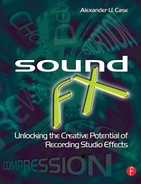The reader is welcome to jump immediately to the chapter dedicated to whichever effect is on their mind. However, the value of all chapters in Sections 2, 3 and 4 is best realized by reading first the material in Section 1. Master the concepts, both fundamental and advanced, in Section 1, and you are then prepared to crack open any of the Amplitude Effects of Section 2 or the Time Effects of Section 3. Presented in a logical order, Amplitude Effects and Time Effects needn′t be read in strict sequence.
The discussion in Section 4 integrates these effects in important applications, from a general mixdown, to the all-important snare drum. That is best saved until after each effect family has been mastered individually, so the preferred approach is to work through Section 4 last. Readers with even an intermediate understanding of audio will find they can start this book anywhere. Of course, those readers have already thumbed ahead to page 131 and may never read this sentence.
The most important music of our time is recorded music. The recording studio is its principle musical instrument. The recording engineers and music producers who create the music we love know how to use signal processing equipment to capture the work of artists, preserving realism or altering things wildly, as appropriate. While the talented, persistent, self-taught engineer can create sound recordings of artistic merit, more productive use of the studio is achieved through study, experience and collaboration. This book defines the technical basis of the most important signal processing effects used in the modern recording studio, highlights the key drivers of sound quality associated with each, shares common production techniques used by recording engineers with significant experience in the field, references many of the touchstone recordings of our time, and equips the reader with the knowledge needed to comfortably use effects devices correctly, and, more importantly, to apply these tools creatively.
Equalization is likely the most frequently used effect of all, reverb the most apparent, delay the most diverse, distortion the most seductive, volume the most underappreciated, expansion the most underutilized, pitch shifting the most abused, and compression the most misunderstood. All effects, in the hands of a talented, informed and experienced engineer, are rich with production possibilities.
Alex Case
Portsmouth, New Hampshire, 2007
